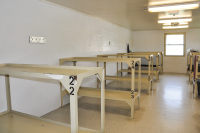Model railroad group brings joy to children and seniors
 By Melanie Threlkeld McConnell • SMN Correspondent
By Melanie Threlkeld McConnell • SMN Correspondent
Think of it as somewhere over the rainbow.
You know the place, only this time not in Oz, in Waynesville, on Frazier Street, behind the parking lot of Sagebrush Steakhouse, in a non-descript building that’s 60-feet long and maybe half that wide. This is where the bluebirds sing, where happiness prevails.
Model trains zip along 200 feet of track on a layout of miniature villages, farms, cities and industrial sites, all set against backdrops of blue skies and puffy white clouds. Whistles blow from some of the engines, smoke puffs out of others as they wend their way through slices of classic Americana. The level of detail in these vignettes is astounding: a garden, a sty with muddy pigs, an industrial park, coal cars, water towers, city buildings, people, grass and more. Even the Frosty Bar has customers. All scenes from a time when the country was booming and railroads were king.
“What we tried to do with this particular layout is show what the trains did,” said Harold Clackett, a member of the Smoky Mountain Model Rail Road Club, which hosted an open house last week for the public. “We show a farm with cows and how trains picked up milk. We have the coal and the lumber and the oil, and these were giant things. This is what made this country grow and it was the train that connected it all.”
Related Items
Marty Maltby of Clyde, agreed. He stopped by to see one of the hallmarks of his youth. “There’s a fascination, a romance with an age gone by and a mode of transportation we don’t see anymore,” he said. “It’s a fascination with an era that made America what it is.”
Waynesville resident Sue Doggett brought her children and grandchildren, 3-year-old twins Eden and Brayden Murphy. “There’s just something about trains,” Doggett said, echoing a sentiment common among the crowd. “They represent a gentler time, or at least it seems like it was back then.”
Club members, who organized about four years ago and run Lionel-type 3 rail O gauge trains, are on a mission to share the joy of model railroading with nursing home residents, school children, and anyone who is interested. Their new workspace at 130 Frazier Street, Suite 13, is filled with four different layouts: Christmas, winter, Thomas the Tank Engine, and their largest – the 50-feet by 30-feet operating layout. The group holds work sessions from 7 to 9 p.m. every Tuesday night and public viewing sessions from 2 to 4 p.m. the second Sunday of each month. New members are urged to join.
“We started out with portable tables to take to nursing homes,” Clackett, 69, said. “This is the third building we’ve been in. The others were sold and we had to move. We really wanted to get this set up so we could invite the community to come in and see what a big layout is like.”
Club members have spent the past year designing and painting backdrops, building tables and wiring electricity, skills they say they learned as part of this lifetime hobby.
“It’s a wonderful teaching school for children,” said Sam Hopkins, 69, one of the club’s founding members. “You can show them construction, modeling, painting, history, research and photography. Trains are an integral part of our society. Not as much today, as they were for the nursing home generation when trains were a big part of their lives. Our fathers who were in WWII traveled by troop train, which also carried a lot of supplies.”
While model trains certainly attracts plenty of youngsters, it’s the older generation that has a special place in the collective heart of this group, especially for Ed Rynning, 79, of Maggie Valley, the club’s resident electrician.
“I’d keep hearing them talk about taking the trains to retirement homes, so I thought ‘I’m going to stick around these guys. This is something I’d like to see,’” said Rynning.
Why the connection? “[Nursing home residents] associate trains with when they were children, when they rode on trains,” said Clackett. “It just connects to them right away. One woman saw our Santa Fe and remembered riding the train. She said, ‘That’s a Super Chief.’ ”
The club’s favorite story is the one about a nursing home resident who rarely smiled, until the trains showed up, Hopkins said.
“A nurse pointed to an elderly gentleman sitting in a wheelchair with his face just beaming like a little boy watching the trains. She said, ‘See that man? This is the first time we’ve seen him smile in eight or nine months here.’ The trains always have a positive effect on people. We look at events like this as our primary ministry.”









